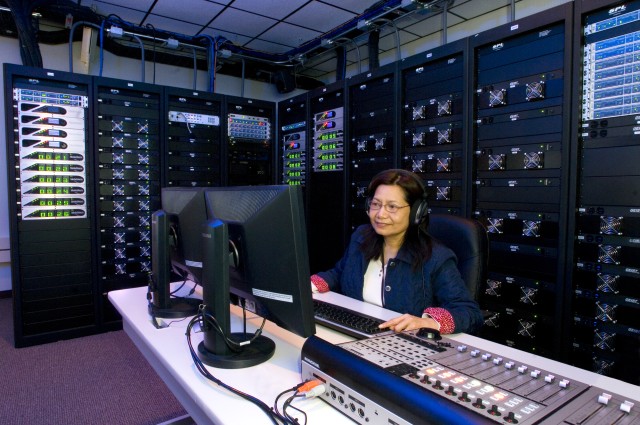ABERDEEN PROVING GROUND, Md. -- The importance of a Soldier's ability to hear a wide range of sounds is critical to survival and mission success on the battlefield. In today's military environment, the harshness of various sounds produced by both military and non-military activities makes it difficult for the Soldier to separate useful signals from background noise.
A Soldier's ability to hear can be corrupted by physical barriers such as ballistics helmets, mission-oriented protective posture headgear, communications headsets and hearing protection devices.
With the ultimate need for Soldiers to accomplish their mission, it is critical to determine both the limits of human hearing and the effects of Soldier equipment on perception of sounds encountered on the battlefield. In order to facilitate research in this area, the U.S. Army Research Laboratory recently completed the Environment for Auditory Research at Aberdeen Proving Ground, Md.
The concept and blueprint of the EAR were developed by ARL Fellow Tom Letowski and Bruce Amrein, chief of the Visual and Auditory Processes Branch.
A team of ARL researchers conducts basic and applied auditory and speech perception research, aiding situational awareness and survivability of ground troops. Areas of research include the perception of acoustic signatures produced by military-relevant sound sources, speech communication in adverse environments, effects of mental and physical workload on performance of the human auditory system, effects of various types of headgear on detection, and identification and localization of specific acoustic signatures.
In order to support this research, the EAR facility has been designed to be re-configurable to simulate a wide range of indoor and outdoor acoustic environments. A researcher's ability to re-create soundscapes from both urban and rural surroundings is an important property and just one example of the many capabilities of the facility.
"The use of controlled space is imperative in order to integrate certain conditions," explained Amrein. "For example, sound sources, reflective surfaces and head-mounted equipment must all be emulated in the controlled setting. The capability to mix in relevant military sounds and have an actual body present to give feedback quantifies the effects and impacts of auditory research."
EAR is a distinctive and flexible research facility. The combination of the research spaces and capabilities is unmatched at any military, academic or industrial facility worldwide. The facility currently covers four indoor areas including the Sphere Room, Distance Hall, Dome Room and Listening Laboratory, as well as one outdoor space, OpenEAR.
All spaces are controllable from one room, and the facility can accommodate up to three independent experiments simultaneously.
The Sphere Room was created as the auditory virtual reality space for research in spatial perception and to evaluate various 3-D system implementations. The room contains 57 loudspeakers located in a spherical arrangement and an instrumented listener's station to collect a variety of listener's responses.
"The current version of the listener's station allows us to collect a wide range of overt human responses including speech, direction pointing and screen touching, while future plans include collection of physiological responses," Amrein noted.
The Dome Room was built for research in auditory localization with a dense array of loudspeakers and can be configured to evaluate perception of sound in a hemispherical space. The Dome is designed to hold 180 loudspeakers in the horizontal plane and 60 loudspeakers at various elevations.
"If a human can differentiate two locations, we can measure it, regardless how closely they are located to each other," said Amrein.
The Distance Hall was created for research in distance estimation and auditory depth perception and is shaped like an elongated rectangular box. It is capable of projecting sound from the 180 loudspeakers that can be placed at almost any point in the space.
"Humans are very poor in reporting auditory distances and there was almost no research done on human sensitivity to changes in auditory distance," said Letowski. "It is important for the Soldier to determine if two gun shots... came from the same location or from two different locations."
The Listening Lab was designed for research in speech perception and enables evaluation of speech traffic coming from up to ten talkers located in various locations. The facility also has adjustable acoustic properties including variable reverberation time and variable pattern of early reflections.
"One of our design guidelines in creating EAR was to make its sound reproduction capabilities compatible with those used in major Army simulations developed by the Institute for Creative Technologies," indicated Amrein. "The Listening Laboratory was created to meet this requirement."
Lastly, the OpenEAR was designed for auditory research in real outdoor environments.
"The presence of the OpenEAR in the EAR structure is really the most important element of the EAR," said Letowski. "There is no other place where basic data collection under stringent and fully controllable listening conditions can be done together with real-world field data collection using the same people and equipment and be done at almost the same time."
The uniqueness of the EAR facility is the amount and extent of studies that will be conducted involving auditory distance and depth perception as well as studies focused on the identification of acoustic signatures of personal weapons; effects of mental load; sound familiarity; and sound expectancy on sound detection and response time. In the future, the effects of various types of helmets will also be examined.
Two of the first completed experiments involved localizing a target sound from a distance and estimating the direction of footsteps. ARL researchers are also collaborating with several external organizations such as the Missouri University of Science and Technology and Starkey Laboratories.
"There are still more things that we would like to add to EAR, but it is time now to demonstrate its usefulness," said Letowski.


Social Sharing